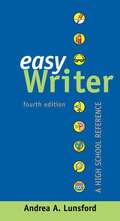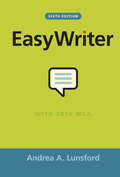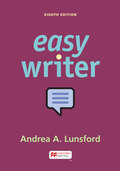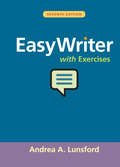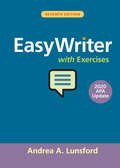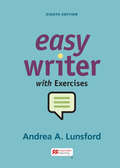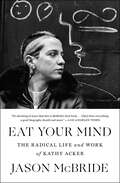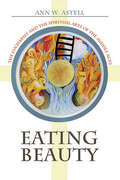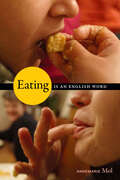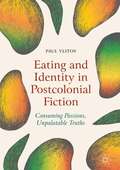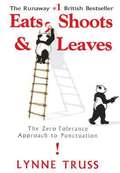- Table View
- List View
Easy Spanish Phrase Book NEW EDITION: Over 700 Phrases for Everyday Use (Dover Language Guides Spanish)
by Dr Pablo Garcia LoaezaDesigned as a quick reference tool and an easy-to-use study guide, this inexpensive and up-to-date book offers fast, effective communications. The perfect companion for tourists and business travelers in Spain and Latin America, it features words, phrases, and sentences that cover everything from asking directions to ordering dinner.Over 700 conveniently organized expressions include terms for modern telecommunications as well as phrases related to transportation, shopping, medical and emergency situations, and other common circumstances. A phonetic pronunciation accompanies each phrase.
Easy Spanish Step-by-Step
by Barbara BregsteinEasy Spanish Step by Step proves that a solid grounding in grammar basics is the key to mastering a second language. Grammatical rules and concepts are clearly explained in order of importance, and more than 300 verbs and key terms are introduced on the basis of frequency. Numerous exercises and engaging readings help learners quickly build their Spanish speaking and comprehension prowess.
Easy Writer: A High School Reference
by Andrea A. Lunsford Christine M. Tardy Paul Kei Matsuda Steven FoxAll writers make choices — and better choices get better results. EasyWriter: A High School Referenceoffers essential help with grammar, mechanics, and documentation, then goes beyond the basics with Andrea Lunsford’s trademark attention to critical thinking, argument, and language choices. This special high school edition features a hard cover to stand the test of time, plus new sections on topics crucial to high school success — all in a book that’s easy to use, easy to carry, and easy to afford.
Easy Writer: A High School Reference (Fourth Edition)
by Andrea A. Lunsford Christine M. Tardy Paul Kei Matsuda Steven FoxThis book offers essential help with grammar, mechanics, and documentation,critical thinking, argument, and language choices.
EasyWriter
by Andrea A. LunsfordEasyWriter is the little handbook with the Andrea Lunsford difference. It features Andrea’s friendly voice, her research-based Top Twenty, her recognition that writing today is increasingly digital and multimodal, and above all, her respect and appreciation for student writers’ potential to change the world. When your students need reliable, easy-to-find writing advice for college and beyond, EasyWriter gives them what they need in a format that’s easy to use and easy to afford. The sixth edition packs in even more support for writing academic and real-world genres, with examples of over 40 types of writing in the print and digital resources, and thoroughly revised documentation advice based on the 2016 MLA guidelines.
EasyWriter
by Andrea A. LunsfordWhen your students need reliable, easy-to-find writing advice for college and beyond, EasyWriter gives them what they need in a format that’s easy to afford. Andrea Lunsford meets students where they are with friendly advice, research-based tips for solving the Top Twenty writing problems, and an emphasis on making effective rhetorical choices. The seventh edition puts even more emphasis on empowering students to become critical thinkers and ethical communicators with new advice about fact checking and evaluating sources and more advice about choosing language that builds common ground. In addition, the seventh edition offers more support for writing in a variety of disciplines and genres and more models of student writing to help students make effective choices in any context.
EasyWriter
by Andrea A. LunsfordEasyWriter gives friendly, reliable writing help in formats that are easy to use and easy to afford. What’s more, this little book offers big ideas from Andrea Lunsford: that reading critically and writing well empower us, that language helps writers face challenges and meet opportunities, and that engaging with others and in our own learning is transformative. Inspiring and trusted advice plus powerful digital tools means the choice is Easy.
EasyWriter with 2020 APA Update
by Andrea A. LunsfordWhen your students need reliable, easy-to-find writing advice for college and beyond, EasyWriter gives them what they need in a format that’s easy to afford. Andrea Lunsford meets students where they are with friendly advice, research-based tips for solving the Top Twenty writing problems, and an emphasis on making effective rhetorical choices. The seventh edition puts even more emphasis on empowering students to become critical thinkers and ethical communicators with new advice about fact checking and evaluating sources and more advice about choosing language that builds common ground. In addition, the seventh edition offers more support for writing in a variety of disciplines and genres and more models of student writing to help students make effective choices in any context.
EasyWriter with Exercises
by Andrea A. LunsfordWhen your students need reliable, easy-to-find writing advice for college and beyond, EasyWriter with Exercises gives them what they need in a format that's easy to afford. Andrea Lunsford meets students where there are with friendly advice, research-based tips for solving the Top Twenty writing problems, and an emphasis on making effective rhetorical choices. The seventh edition puts even more emphasis on empowering students to become critical thinkers and ethical communicators with new advice about fact checking and evaluating sources and more advice about choosing language that builds common ground. In addition, the seventh edition offers more support for writing in a variety of disciplines and genres and more models of student writing to help students make effective choices in any context.
EasyWriter with Exercises
by Andrea LunsfordWith 2020 APA Update. When your students need reliable, easy-to-find writing advice for college and beyond, EasyWriter with Exercises gives them what they need in a format that’s easy to afford. Andrea Lunsford meets students where there are with friendly advice, research-based tips for solving the Top Twenty writing problems, and an emphasis on making effective rhetorical choices. The seventh edition puts even more emphasis on empowering students to become critical thinkers and ethical communicators with new advice about fact checking and evaluating sources and more advice about choosing language that builds common ground. In addition, the seventh edition offers more support for writing in a variety of disciplines and genres and more models of student writing to help students make effective choices in any context. EasyWriter with Exercises can be packaged at a significant discount with LaunchPad Solo for Lunsford Handbooks, which includes dozens of additional writing models as well as exercises, LearningCurve adaptive quizzing, videos, and podcasts.
EasyWriter with Exercises
by Andrea LunsfordWith coverage of critical reading and writing skills, EasyWriter with Exercises empowers you to make effective writing choices for all your writing situations. It’s easy to use and easy to afford!
Eat Your Mind: The Radical Life and Work of Kathy Acker
by Jason McBrideThe first full-scale authorized biography of the pioneering experimental novelist Kathy Acker, one of the most original and controversial figures in 20th-century American literature.Kathy Acker (1947–1997) was a rare and almost inconceivable thing: a celebrity experimental writer. Twenty-five years after her death, she remains one of the most original, shocking, and controversial artists of her era. The author of visionary, transgressive novels like Blood and Guts in High School; Empire of the Senses; and Pussy, King of Pirates, Acker wrote obsessively about the treachery of love, the limitations of language, and the possibility of revolution. She was notorious for her methods—collaging together texts stolen from other writers with her own diaries, sexual fantasies, and blunt political critiques—as well as her appearance. With her punkish hairstyles, tattoos, and couture outfits she looked like no other writer before or after. Her work was exceptionally prescient, taking up complicated conversations about gender, sex, capitalism, and colonialism that continue today. Acker&’s life was as unruly and radical as her writing. Raised in a privileged but oppressive Upper East Side Jewish family, she turned her back on that world as soon as she could, seeking a life of romantic and intellectual adventure that led her to, and through, many of the most thrilling avant-garde and countercultural moments in America: the births of conceptual art and experimental music; the poetry wars of the 60s and 70s; the mainstreaming of hardcore porn; No Wave cinema and New Narrative writing; Riot grrls, biker chicks, cyberpunks. As this definitive biography shows, Acker was not just a singular writer, she was also a titanic cultural force who tied together disparate movements in literature, art, music, theatre, and film. A feat of literary biography, Eat Your Mind is the first full-scale, authorized life of Acker. Drawing on exclusive interviews with hundreds of Acker&’s intimates as well as her private journals, correspondence, and early drafts of her work, acclaimed journalist and critic Jason McBride offers a thrilling account and a long overdue reassessment of a misunderstood genius and revolutionary artist.
Eat Your Words: A Fascinating Look At The Language Of Food
by Charlotte Foltz Jones John O'BrienBaked Alaska, melba toast, hush puppies, and coconuts. You'd be surprised at how these food names came to be. And have you ever wondered why we use the expression "selling like hotcakes"? Or how about "spill the beans"? There are many fascinating and funny stories about the language of food--and the food hidden in our language! Charlotte Foltz Jones has compiled a feast of her favorite anecdotes, and John O'Brien's delightfully pun-filled drawings provide the dessert. Bon appetit!
Eat Your Words: The Definitive Dictionary for the Discerning Diner
by Paul Convery“An outstanding contribution to the field of food language and lore and an accessible reference book for professional and amateur foodies alike.” —Susannah Seton, author of Simple Pleasures of the KitchenEat Your Words is a gloriously gluttonous glossary of all things grub and gastronomy: It’s a true treat for anyone who loves language as much as they love food. With witty and fun definitions of everything from aeroponics to zoosaprophagy, this compilation offers definitions of six thousand unusual and unfamiliar terms across twenty-one fact-packed courses.For bon viveurs and verbivores alike: Are you a gourmet who knows the difference between Maldon and Morton salt? Maybe you’re an expert on the properties of heat in cooking. Or you’re a cocktail connoisseur with a taste for tequila. Eat Your Words is a surprising treat for anyone who loves learning about food and cooking.A delight for word nerds: For Scrabble stars and anyone who excels at Words with Friends, Eat Your Words is a clever guide to little-known culinary terms that will give you that special edge.In Eat Your Words, you’ll find terms about:A cornucopia of culinary treats from around the worldThe cultivation, selling, and serving of every food you can imagineThe appetites of diners and their dinners across all speciesThis new dictionary is the fun reference book you didn’t know you wanted. Fans of Tequila Mockingbird and On Food and Cooking will enjoy this fascinating journey into the language of food and eating.“Now I can impress my food-snob friends with more than my ratatouille and learn some great food-related Scrabble words as well.” —Nina Lesowitz, author of The Party Girl Cookbook
Eat and Be Eaten: How an Ecologist Uses Food Webs (SEEDS Book Reader)
by Jonathan CurleyNIMAC-sourced textbook
Eating Beauty: The Eucharist and the Spiritual Arts of the Middle Ages
by Ann W. Astell"The enigmatic link between the natural and artistic beauty that is to be contemplated but not eaten, on the one hand, and the eucharistic beauty that is both seen (with the eyes of faith) and eaten, on the other, intrigues me and inspires this book. One cannot ask theo-aesthetic questions about the Eucharist without engaging fundamental questions about the relationship between beauty, art (broadly defined), and eating."—from Eating BeautyIn a remarkable book that is at once learned, startlingly original, and highly personal, Ann W. Astell explores the ambiguity of the phrase "eating beauty." The phrase evokes the destruction of beauty, the devouring mouth of the grave, the mouth of hell. To eat beauty is to destroy it. Yet in the case of the Eucharist the person of faith who eats the Host is transformed into beauty itself, literally incorporated into Christ. In this sense, Astell explains, the Eucharist was "productive of an entire 'way' of life, a virtuous life-form, an artwork, with Christ himself as the principal artist." The Eucharist established for the people of the Middle Ages distinctive schools of sanctity—Cistercian, Franciscan, Dominican, and Ignatian—whose members were united by the eucharistic sacrament that they received.Reading the lives of the saints not primarily as historical documents but as iconic expressions of original artworks fashioned by the eucharistic Christ, Astell puts the "faceless" Host in a dynamic relationship with these icons. With the advent of each new spirituality, the Christian idea of beauty expanded to include, first, the marred beauty of the saint and, finally, that of the church torn by division—an anti-aesthetic beauty embracing process, suffering, deformity, and disappearance, as well as the radiant lightness of the resurrected body. This astonishing work of intellectual and religious history is illustrated with telling artistic examples ranging from medieval manuscript illuminations to sculptures by Michelangelo and paintings by Salvador Dalí. Astell puts the lives of medieval saints in conversation with modern philosophers as disparate as Simone Weil and G. W. F. Hegel.
Eating Is an English Word
by Annemarie MolEating is generally understood as a human need that people satisfy in diverse ways. Eating, however, is also an English word. Other languages, using other words, order reality differently: they may fuse eating with breathing, or distinguish chupar from comer. Anthropologists flag such differences by leaving a few of their words untranslated, but what language do we think in? This isn’t necessarily English. We may be linguistically closer to those whose practices we study: them. Against this background, Eating Is an English Word argues that social scientists should let go of the dream of universal concepts. Our analytical terms had better vary. Annemarie Mol and her coauthors exemplify this in a series of material semiotic inquiries into eating practices. They employ terms like lekker, tasting with fingers, chupar, schmecka, gustar, and settling on an okay meal to explore appreciative modes of valuing. Welcome, then, to spirited stories about satisfied stomachs, love for a lamb, juicy fruit treats, and companionable lunches and dinners.
Eating Otherwise: The Philosophy of Food in Twentieth-Century Literature
by Maria ChristouThis book explores the philosophical implications of the popular adage that 'you are what you eat' through twentieth-century literature. It investigates the connections between the alimentary and the ontological: between what or how one eats and what one is. Maria Christou's focus is on two influential modernist figures, Georges Bataille and Samuel Beckett; and two influential postmodernist figures, Paul Auster and Margaret Atwood. She aims to theorize the relationship between modernism and postmodernism from a specifically alimentary perspective. By examining the work of these major twentieth-century authors, this book focuses on strange or unusual acts of eating - 'eating' otherwise - as a means to ways of 'being' otherwise. What can eating tell us about being, about who we are and about our being in the world? This powerful, innovative study takes literary food studies in a new direction.
Eating and Ethics in Shakespeare's England
by David B. GoldsteinDavid B. Goldstein argues for a new understanding of Renaissance England from the perspective of communal eating. Rather than focus on traditional models of interiority, choice and consumption, Goldstein demonstrates that eating offered a central paradigm for the ethics of community formation. The book examines how sharing food helps build, demarcate and destroy relationships – between eater and eaten, between self and other, and among different groups. Tracing these eating relations from 1547 to 1680 – through Shakespeare, Milton, religious writers and recipe book authors – Goldstein shows that to think about eating was to engage in complex reflections about the body's role in society. In the process, he radically rethinks the communal importance of the Protestant Eucharist. Combining historicist literary analysis with insights from social science and philosophy, the book's arguments reverberate well beyond the Renaissance. Ultimately, Eating and Ethics in Shakespeare's England forces us to rethink our own relationship to food.
Eating and Identity in Postcolonial Fiction: Consuming Passions, Unpalatable Truths
by Paul VlitosThis book focuses on the fiction of four postcolonial authors: V.S. Naipaul, Anita Desai, Timothy Mo and Salman Rushdie. It argues that meals in their novels act as sites where the relationships between the individual subject and the social identities of race, class and gender are enacted. Drawing upon a variety of academic fields and disciplines — including postcolonial theory, historical research, food studies and recent attempts to rethink the concept of world literature — it dedicates a chapter to each author, tracing the literary, cultural and historical contexts in which their texts are located and exploring the ways in which food and the act of eating acquire meanings and how those meanings might clash, collide and be disputed. Not only does this book offer suggestive new readings of the work of its four key authors, but it challenges the reader to consider the significance of food in postcolonial fiction more generally.
Eating the Alphabet Fruits and Vegetables from A to Z
by Lois EhlertAn alphabetical tour of the world of fruits and vegetables, from apricot and artichoke to yam and zucchini, including descriptions of 75 fruits and vegetables.
Eating the Alphabet: Fruits & Vegetables from A to Z
by Lois EhlertA vibrant and sturdy word book starring fruits and vegetables from around the world from Caldecott Honor–winning author-illustrator Lois Ehlert. Features upper- and lowercase letters for preschoolers just learning language.Each turn of the page reveals a mouth-watering arrangement of foods: Indian corn, jalapeno, jicama, kumquat, kiwifruit and kohlrabi. Lois Ehlert's lively watercolors paired with bold easy-to-read type make for a highly appealing and accessible book for parents and children to devour.At the end of the book, Ehlert provides a detailed glossary that includes pronunciation, botanical information, the origin and history of the particular plant and occasional mythological references, with a small watercolor picture to remind the reader of what the plant looks like.Apple to Zucchini,come take a look.Start eating your waythrough this alphabet book.
Eats, Shoots & Leaves: The Zero Tolerance Approach to Punctuation
by Lynne TrussAnxious about the apostrophe? Confused by the comma? Stumped by the semicolon? Join Lynne Truss on a hilarious tour through the rules of punctuation that is sure to sort the dashes from the hyphens. We all had the basic rules of punctuation drilled into us at school, but punctuation pedants have good reason to suspect they never sank in. 'Its Summer!' screams a sign that sets our teeth on edge. 'Pansy's ready', we learn to our considerable interest ('Is she?') as we browse among the bedding plants. It is not only the rules of punctuation that have come under attack but also a sense of why they matter. In this runaway bestseller, Lynne Truss takes the fight to emoticons and greengrocers' apostrophes with a war cry of 'Sticklers unite!'
Eats, Shoots and Leaves: The Zero Tolerance Approach to Punctuation
by Lynne TrussEnglish spelling, punctuation, and grammatical terms, (e.g., "stop" for our "period") are deliberately retained in this U.S. edition, as the publisher states in his Note. Chapters on present and former use of the comma, apostrophe, colon, semicolon, dash, ellipses, other punctuation marks presented with humor. You'll laugh and be entertained as well as edified. People who read by listening will have a problem because the words will sound the same whether they are spelled nd punctuated correctly or not, e.g., d o n apostrophe t or d o n t. You may need to have punctuation spoken, at least for the chapter on the apostrophe, or have someone read to you and explain.


